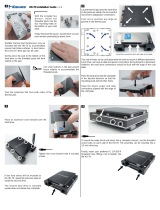
Chapter 1: Working on your computer...............................................................................................5
Safety instructions................................................................................................................................................................ 5
Turning off your computer — Windows 10....................................................................................................................... 5
Before working inside your computer................................................................................................................................. 6
After working inside your computer....................................................................................................................................6
Chapter 2: Technology and components........................................................................................... 7
DDR4....................................................................................................................................................................................... 7
USB features..........................................................................................................................................................................8
USB Type-C..........................................................................................................................................................................10
Intel Optane memory........................................................................................................................................................... 10
Enabling Intel Optane memory...................................................................................................................................... 11
Disabling Intel Optane memory......................................................................................................................................11
Intel UHD Graphics 620....................................................................................................................................................... 11
Nvidia GeForce MX130 equivalent.....................................................................................................................................12
Chapter 3: Major components of your system ................................................................................. 13
Chapter 4: Removing and installing components.............................................................................. 15
Recommended tools............................................................................................................................................................ 15
Secure Digital Card.........................................................................................................................................................15
Base cover.......................................................................................................................................................................17
Battery............................................................................................................................................................................ 22
Hard drive....................................................................................................................................................................... 26
IO board.......................................................................................................................................................................... 29
Touchpad........................................................................................................................................................................32
Memory modules........................................................................................................................................................... 36
SIM Card......................................................................................................................................................................... 37
WLAN card..................................................................................................................................................................... 39
WWAN card.................................................................................................................................................................... 41
WWAN daughterboard................................................................................................................................................. 43
Solid-state drive/Intel Optane memory module........................................................................................................ 47
Speakers......................................................................................................................................................................... 57
System fan...................................................................................................................................................................... 61
Heat sink.........................................................................................................................................................................65
VGA daughterboard...................................................................................................................................................... 69
Power-button board......................................................................................................................................................72
System board................................................................................................................................................................. 75
Display assembly.............................................................................................................................................................81
Display bezel...................................................................................................................................................................89
Display panel...................................................................................................................................................................93
Display cable...................................................................................................................................................................99
Power-adapter port..................................................................................................................................................... 103
Camera.......................................................................................................................................................................... 105
Contents
Contents 3





















